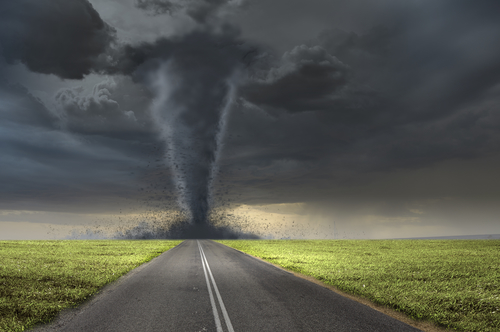More than 1,200 tornadoes occur in the USA each year, a greater number than in any other country in the world. About $10 billion of damage is caused annually by these violent whirlwinds, which reach from the base of a thunderstorm down to the ground. If you are moving to a tornado zone, you need to plan for these potential emergencies, get insurance, and keep up to date with local weather conditions.
Where Do Tornadoes Strike In The USA?
Mild tornadoes – defined as category F1, with wind speeds up to 72 miles per hour – can occur anywhere across the country. However, states east of the Rocky Mountains are particularly vulnerable to more violent tornadoes, especially the state of Florida. Central US states including Alabama, Indiana and Oklahoma suffer tornado storms so frequently that the media has nicknamed the area ‘tornado alley’. Wind speeds here can reach more than an astonishing 300 miles per hour, and several people are killed by tornadoes in these areas most years.
Is your prospective home on the tornado alley map? This might be hard to answer, as there are several different maps you could consult, since there are different ways to measure a tornado. Do also bear in mind that many deadly tornadoes occur outside these areas. However, if your new home will be in an area identified on any tornado alley map, in Florida or any other high-risk tornado area, looking at past weather events will prepare you for the level of risk you need to be aware of.
When Are Tornadoes Likely To Occur?
Particular times of the year bring greater risk in different areas, when you must stay alert to the weather reports on the TV and radio. During spring, the Gulf coast will suffer more tornadoes than usual; during May and June the southern plains are particularly vulnerable; while in June and July, the risks move to the northern plains and upper Midwest.
Most tornadoes will occur between 4pm and 9pm. One advantage of this is that you will hear the weather alerts and can act accordingly, during daylight hours. The disadvantage is that the tornadoes may strike when your family is scattered between work, school and other locations.
Planning For A Tornado
Everyone in your family needs to know what to do in the event of a tornado; waiting until it actually happens will be too late.
Well-prepared families have an emergency plan ready. Write a list of the items you will need: water, food, medicines, first aid kit, torch and extra batteries, radio and mobile phones are amongst the items to remember.

If you are a homeowner, you will need to ensure that tornado damage is covered by your buildings and contents insurer. Most policies will include this cover within a domestic policy without additional clauses or exclusions, but be sure to check. The same applies to insurance for road vehicles; fully comprehensive cover usually includes tornado damage but remember to check the small print.
If you are renting a property, your landlord should insure the building. However, responsibility for insuring the contents of a property is yours. Tornadoes can completely destroy all types of building, so you could be unlucky and lose everything. Check that your contents insurance covers tornado damage, and that it will be sufficient to cover your costs if you need to start from scratch.
Be Alert
Regardless of your location, time of year or time of day, a tornado can occur in the US. Be aware of the tornado watch alerts issued across the media, which let the public know that weather conditions signify an increased risk of tornado. This gives you a chance to check your family emergency plan and remind everyone what to do if the tornado hits.
The National Oceanic and Atmospheric Agency (NOAA) runs the NOAA Weather Radio, which is broadcast on seven dedicated frequencies and can be accessed via an app. Along with the local radio stations, the NOAA Weather Radio is a useful way to keep informed about tornado conditions.
Once the tornado watch has turned into a tornado warning – where a tornado has been sighted or identified on radar – it is imperative that you act.
Emergency Action Plan
Quickly collect all the items listed on your emergency plan, then find shelter and stay there. Film footage of the storm chasers make for excellent TV, but the people who make these films are genuinely putting their lives in danger. Do not be tempted to make a great home movie of your backyard being ripped up. The air will be full of flying debris; you may be injured or killed by a piece of broken glass, a splintered fencing post or a collapsing roof. You need to be in a safe space with secure walls, doors, roof and windows.

The wind speeds of a tornado are calculated after it has passed, by assessing the amount of damage it caused. You cannot assume any tornado will be a small one, so always find shelter.
Where Are Your Local Shelters?
In 2013, a tornado destroyed two schools in Moore, Oklahoma, a tornado alley state where only a third of schools had shelters. Of the twenty-four people who sadly died that day, seven tragically were children hiding in unfortified classrooms. No US states require schools to have shelters, even if they are in a high-risk area. Schools are funded differently than in Europe, meaning their budgets reflect the wealth of local communities. This is an unexpected but important issue to consider when choosing a school for your child in the USA.
Workplaces will also vary in their access to shelters. If you are not informed of a shelter during your work induction, ask your work colleagues what the company’s tornado warning policy is.
At home, assess the level of tornado risk and your building’s ability to withstand such an event. It is possible to adapt buildings and create a safe room, but these projects can be expensive. Therefore, some homeowners are helped with grants, loans and advice. The Federal Emergency Management Agency (FEMA) website is a great place to start your planning. This site answers a number of important questions about the location and design of a safe room and provides the number for the FEMA Safe Room Helpline.
Mobile homes are particularly at risk during a tornado, and have the most likelihood of injuring or killing the occupants. Unlike in Europe, mobile homes in the USA are a popular way to house individuals and families, especially those surviving on low incomes. During a tornado, flimsy mobile homes are easily destroyed, damaged or flipped over by winds reaching more than 300 miles per hour. If you decide a mobile home is a convenient temporary home or weekend retreat, take care to leave well before wind speeds pick up.
Plan, Prepare And Shelter
This short Youtube video is an excellent introduction to keeping you and your family safe from tornadoes. Remember that the key to staying safe is to plan, prepare and shelter.

